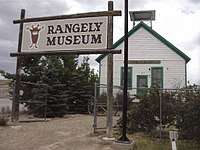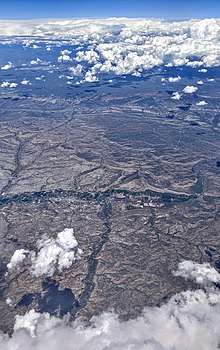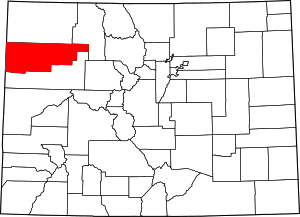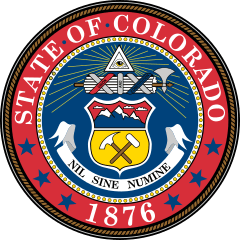Rangely, Colorado
Rangely is a Statutory Town in Rio Blanco County, Colorado, United States. The population was 2,365 at the 2010 census. The town is home to one of two campuses of the Colorado Northwestern Community College.
Town of Rangely, Colorado | |
|---|---|
 Rangely Museum | |
| Nickname(s): Way outside of ordinary! | |
 Location of Rangely in Rio Blanco County, Colorado. | |
| Coordinates: 40°5′10″N 108°47′53″W | |
| Country | |
| State | |
| County[1] | Rio Blanco |
| Incorporated (town) | August 27, 1946[2] |
| Government | |
| • Type | Statutory Town[1] |
| • Mayor | Andy Shaffer[3] |
| • Town Manager | Lisa Piering[3] |
| Area | |
| • Total | 4.30 sq mi (11.15 km2) |
| • Land | 4.30 sq mi (11.15 km2) |
| • Water | 0.00 sq mi (0.00 km2) |
| Elevation | 5,297 ft (1,615 m) |
| Population (2010) | |
| • Total | 2,365 |
| • Estimate (2019)[6] | 2,263 |
| • Density | 525.91/sq mi (203.04/km2) |
| Time zone | UTC−7 (Mountain (MST)) |
| • Summer (DST) | UTC−6 (MDT) |
| ZIP code[7] | 81648 |
| Area code(s) | 970 |
| FIPS code | 08-62880 |
| GNIS feature ID | 0171670 |
| Website | Town of Rangely |
A post office called Rangely was established in 1884.[8] The community was named after Rangeley, Maine, the native home of a local businessperson.[9]
Geography

Rangely is located at 40°5′10″N 108°47′53″W (40.086181, -108.797944).[10]
According to the United States Census Bureau, the town has a total area of 4.0 square miles (10 km2), all of it land.
The terrain is mountain desert and is dry for most of the year.
History
The land is what makes the town of Rangely's history interesting. The land is the base from which all human events unfold, whether it is the geology that brought the miners and oil men, or the water that brought the Fremonts, the Utes, the explorers, the ranchers.
To tell the story we must start back in the earlier history of the earth when a shallow sea encompassed most of the area around Rangely, 300 million years ago in what is labeled as the Pennsylvania [11] and Permian[12] geologic periods. During this time marine creatures would become fossils[13] and can actually still be discovered around Rangely. Huge dunes were formed on the edges of this sea and became porous rock that is now known as the [./Http://archives.datapages.com/data/rmag/PennRocks58/bissell.htm Weber formation]. This formed what is called an "anticline." Anticline is a ridge-shaped fold of stratified rock in which the strata slope downward from the crest. Then, as the sea receded, dinosaurs left bones and the extensive plant growth became oil and coal.[14]
The innumerable canyons,[15] draws, and gullies[16] of the area held creeks, rivers and streams which attracted the early Fremont and Ute peoples. The Fremont people migrated to the Rangely area from the Great Basin in south-central Utah between 400 B.C. - 650 A.D. What we know about the Fremont comes from the artifacts[17] they left in the area and from their homes and campsites which we find in the nearby canyons. Evidence of the Fremont people is plentiful in and around Rangely; for example, the rock art on Colorado 139 and Dragon Trail are both examples of Fremont Art. A Fremont dwelling in Texas Creek Overlook was an atypical dwelling for the Fremont people.
In many places around Rangely the art echoes images from other sites in the southwest. The art of the historical Utes records their history of conflict with the white settlers who began moving into the area in the 1800s. Their art is also the first to include horses originally brought by the Spanish.
The first recorded white settlers making a permanent home in the area were Mr. Joseph Studer and C.P. Hill [18] who came in 1882, the same year the Ute people were to be confined to reservations in southern Colorado and eastern Utah. Some time later Mr. Hill was joined by his relatives, among them a cousin, Lee S. Chase, who named the town after Rangeley, Maine.[19] Mr. Hil[18] l began ranching and opened a trading post. All supplies were freighted—first from Salt Lake City, Utah, by team and wagon, then from Grand Junction, Colorado, via Douglas Pass. By 1913 there were enough ranching and farming families in the area to necessitate the building of a large one-room school house (now located in the Rangely Outdoor Museum[20]).
Interestingly, the Utes had long been aware of oil in the area. The first shallow wells drilled in 1903 produced about 10 barrels of oil per day. Chevron arrived in 1931. In 1932, after a year of drilling Raven A-1,[21] the first deep oil well, successfully reached the vast pocket of crude in the Weber formation[22] at a depth of more than 6,000 feet, but there was no market for the 230 barrels it produced each day; however, the well was known as the most productive oil well of all time. The well was capped until everything changed for this sleepy little town with the large demand for oil required during the Second World War.[23] Chevron reopened the Raven A-1[21] well and Rangely[24] became a booming oil camp.
By 1946 raising cattle and sheep, farming, shallow oil well drilling, and mining coal were no longer the principle industries. Deep well drilling was king. Tents, trolley cars, crude cabins and trailers took over the dozen homes. The one store, post office, filling station, library, pool hall, Red Cross first aid station, and hotel suddenly had competition from a slew of businesses, including motels, cafes, bars, cleaners, movie theater, bowling alley, and more. The school had been accredited up to three years of high school with senior year taken elsewhere, usually Meeker, or forfeited. Company camps were built in many places in the valley, and in 1947 Rangely[24] was incorporated as a town with Fred Nichols[25] voted in as Mayor.[26] In the 1960s the Rangely oil field was a major producer in the country and deemed such an important strategic asset that bomb shelters were built at the college and supplied with coats, blankets, food and water.[27]
By 1949 there were 478 wells across 30 miles in the Weber formation. The peak rate of the area was 82,000 by 1956. Rangely's oil field was known as the Rangely Weber Sand Unit[28] by 1998 and recovered more than 815 million barrels of oil, making it the largest field in the Rocky Mountain Region. This Region has 406 producing wells, 351 injection wells and produces about one third of Colorado's oil production coming out to a huge 20,000 barrels a day. The Weber Basin, has recovered an additional 12 million barrels of oil from the shallower Mancos Shale at depths less than 2000 feet. The Sand Unit is a unitized field so is owned by many, but only Chevron USA Production operates the field. Major oil companies, smaller independent oil companies, trust and individuals numbering almost 30 share the expenses and the benefits of the field today. The Unit provides jobs for approximately 300 individuals and makes up about 70 percent of the property tax revenue for Rio Blanco County.
In 2015, Colorado Northwestern Community College, Rangely Campus, began the excavation of an important fossil dig of the bones and very rare skin and tendons of a Duckbill Dinosaur which was located in Rangely. The Duckbill Dinosaur, which ultimately took on the name of Walter, was excavated and the fossils were airlifted to a federal repository on Colorado Northwestern Coummunity College's Craig Campus on Thursday, July 11, 2019. With this event, along with the formation of the town, one can see how the past continues to link with the present to make Rangely's story interesting and ongoing.
Historic places
Near Rangely are the following prehistoric Fremont culture sites listed as National Register of Historic Places:[29]
- Prehistoric sites
- Collage Shelter Site – dated from 500–1499 AD.
- Cañon Pintado – dated from 500–1899 AD.
- Carrot Men Pictograph Site – dated from 500–1499 AD.
- Fremont Lookout Fortification Site – dated from 0–1499 AD
Demographics
| Historical population | |||
|---|---|---|---|
| Census | Pop. | %± | |
| 1950 | 808 | — | |
| 1960 | 1,464 | 81.2% | |
| 1970 | 1,591 | 8.7% | |
| 1980 | 2,113 | 32.8% | |
| 1990 | 2,278 | 7.8% | |
| 2000 | 2,096 | −8.0% | |
| 2010 | 2,365 | 12.8% | |
| Est. 2019 | 2,263 | [6] | −4.3% |
| U.S. Decennial Census[30] | |||
As of the 2000 census,[31] there were 2,096 people, 749 households, and 546 families residing in the town. The population density was 518.4 people per square mile (200.3/km2). There were 899 housing units at an average density of 222.4 per square mile (85.9/km2). The racial makeup of the town was 94.42% White, 0.43% African American, 1.05% Native American, 0.43% Asian, 1.62% from other races, and 2.05% from two or more races. Hispanic or Latino of any race were 5.20% of the population.
There were 749 households, out of which 41.4% had children under the age of 18 living with them, 57.5% were married couples living together, 10.1% had a female householder with no husband present, and 27.1% were non-families. 23.4% of all households were made up of individuals, and 6.3% had someone living alone who was 65 years of age or older. The average household size was 2.59 and the average family size was 3.05.
In the town, the population was spread out, with 28.3% under the age of 18, 14.4% from 18 to 24, 29.6% from 25 to 44, 20.5% from 45 to 64, and 7.3% who were 65 years of age or older. The median age was 31 years. For every 100 females, there were 104.5 males. For every 100 females age 18 and over, there were 103.4 males.
The median income for a household in the town was $41,276, and the median income for a family was $48,438. Males had a median income of $41,220 versus $25,242 for females. The per capita income for the town was $17,668. About 6.3% of families and 9.8% of the population were below the poverty line, including 10.2% of those under age 18 and 4.1% of those age 65 or over.
Landmarks
Rangely is home to an empty water tank called "The Tank" that has been used for months for performances and recordings, due to its unique echo acoustics.[32]
Climate
Rangely has a semi-arid climate (Köppen climate classification BSk) with hot summers, cold winters, and uniform precipitation year-round.
| Climate data for Rangely, Colorado (1981–2010 normals) | |||||||||||||
|---|---|---|---|---|---|---|---|---|---|---|---|---|---|
| Month | Jan | Feb | Mar | Apr | May | Jun | Jul | Aug | Sep | Oct | Nov | Dec | Year |
| Record high °F (°C) | 57 (14) |
67 (19) |
78 (26) |
86 (30) |
95 (35) |
108 (42) |
104 (40) |
103 (39) |
98 (37) |
87 (31) |
74 (23) |
60 (16) |
108 (42) |
| Average high °F (°C) | 32.0 (0.0) |
38.9 (3.8) |
52.9 (11.6) |
62.8 (17.1) |
72.8 (22.7) |
84.3 (29.1) |
91.6 (33.1) |
88.9 (31.6) |
79.2 (26.2) |
65.3 (18.5) |
47.5 (8.6) |
33.0 (0.6) |
62.0 (16.7) |
| Daily mean °F (°C) | 19.0 (−7.2) |
25.8 (−3.4) |
39.3 (4.1) |
47.9 (8.8) |
57.6 (14.2) |
67.5 (19.7) |
74.5 (23.6) |
72.2 (22.3) |
62.5 (16.9) |
49.5 (9.7) |
34.5 (1.4) |
20.8 (−6.2) |
47.3 (8.5) |
| Average low °F (°C) | 5.6 (−14.7) |
12.6 (−10.8) |
25.6 (−3.6) |
33.3 (0.7) |
42.1 (5.6) |
50.8 (10.4) |
57.5 (14.2) |
55.6 (13.1) |
45.7 (7.6) |
33.7 (0.9) |
21.7 (−5.7) |
8.8 (−12.9) |
32.3 (0.2) |
| Record low °F (°C) | −37 (−38) |
−32 (−36) |
−17 (−27) |
−6 (−21) |
8 (−13) |
30 (−1) |
39 (4) |
24 (−4) |
22 (−6) |
1 (−17) |
−15 (−26) |
−29 (−34) |
−37 (−38) |
| Average precipitation inches (mm) | 0.52 (13) |
0.57 (14) |
0.91 (23) |
1.12 (28) |
1.14 (29) |
0.91 (23) |
0.80 (20) |
0.94 (24) |
1.40 (36) |
1.36 (35) |
0.85 (22) |
0.61 (15) |
10.57 (268) |
| Average precipitation days (≥ 0.01 in) | 5 | 5 | 6 | 7 | 7 | 5 | 5 | 7 | 7 | 6 | 5 | 5 | 68 |
| Source: NOAA (extremes 1938–present)[33] | |||||||||||||
References
- "Active Colorado Municipalities". State of Colorado, Department of Local Affairs. Archived from the original on December 12, 2009. Retrieved September 1, 2007.
- "Colorado Municipal Incorporations". State of Colorado, Department of Personnel & Administration, Colorado State Archives. December 1, 2004. Retrieved September 2, 2007.
- http://www.rangely.com/
- "2019 U.S. Gazetteer Files". United States Census Bureau. Retrieved July 1, 2020.
- http://www.rangely.com/FAQGeneral.html
- "Population and Housing Unit Estimates". United States Census Bureau. May 24, 2020. Retrieved May 27, 2020.
- "ZIP Code Lookup". United States Postal Service. Archived from the original (JavaScript/HTML) on November 4, 2010. Retrieved December 19, 2007.
- "Post offices". Jim Forte Postal History. Retrieved 8 July 2016.
- Dawson, John Frank. Place names in Colorado: why 700 communities were so named, 150 of Spanish or Indian origin. Denver, CO: The J. Frank Dawson Publishing Co. p. 43.
- "US Gazetteer files: 2010, 2000, and 1990". United States Census Bureau. February 12, 2011. Retrieved April 23, 2011.
- "Pennsylvanian (geology)", Wikipedia, 2020-02-04, retrieved 2020-02-24
- "Permian", Wikipedia, 2020-02-15, retrieved 2020-02-24
- Society, National Geographic (2013-02-22). "fossil". National Geographic Society. Retrieved 2020-02-24.
- Society, National Geographic (2018-10-05). "Petroleum". National Geographic Society. Retrieved 2020-02-24.
- "Definition of CANYON". www.merriam-webster.com. Retrieved 2020-02-24.
- "Gully", Wikipedia, 2020-02-09, retrieved 2020-02-24
- "Definition of ARTIFACT". www.merriam-webster.com. Retrieved 2020-02-24.
- "Rangely History | Rio Blanco Herald Times | Serving Meeker, Rangely, Dinosaur & Northwest Colorado". www.theheraldtimes.com. 2009-03-25. Retrieved 2020-02-24.
- "Rangeley, Maine", Wikipedia, 2020-02-18, retrieved 2020-02-24
- "Rangely Outdoor Museum". rangely-museum. Retrieved 2020-02-24.
- Zadra, Heather (2015-05-09). "Raven oil pumping station at new home pad in Rangely | Rio Blanco Herald Times | Serving Meeker, Rangely, Dinosaur & Northwest Colorado". www.theheraldtimes.com. Retrieved 2020-02-24.
- Harold J. Bissell, Orlo E. Childs (1958). "The Weber Formation of Utah and Colorado". Cite journal requires
|journal=(help) - "World War II", Wikipedia, 2020-02-23, retrieved 2020-02-24
- https://www.colorado.gov/townofrangely. Missing or empty
|title=(help) - https://www.colorado.gov/pacific/townofrangely/history-18. Missing or empty
|title=(help) - (PDF) https://chambermaster.blob.core.windows.net/userfiles/UserFiles/chambers/7788/CMS/Documents/Rangely-Visitors-Guide-for-Web.pdf. Missing or empty
|title=(help) - (PDF) https://chambermaster.blob.core.windows.net/userfiles/UserFiles/chambers/7788/CMS/Documents/Rangely-Visitors-Guide-for-Web.pdf. Missing or empty
|title=(help) - https://www.colorado.gov/pacific/townofrangely/art-culture. Missing or empty
|title=(help) - National Register of Historic Places in Rio Blanco County American Dreams, Inc. Retrieved October 6, 2011.
- "Census of Population and Housing". Census.gov. Retrieved June 4, 2015.
- "U.S. Census website". United States Census Bureau. Retrieved January 31, 2008.
- The Tank: Coloradans Make Music Venue From Rusty Water Tank Front Range Alternative Retrieved 12/25/2016.
- "NowData - NOAA Online Weather Data". National Oceanic and Atmospheric Administration. Retrieved May 30, 2016.
External links
| Wikimedia Commons has media related to Rangely, Colorado. |

